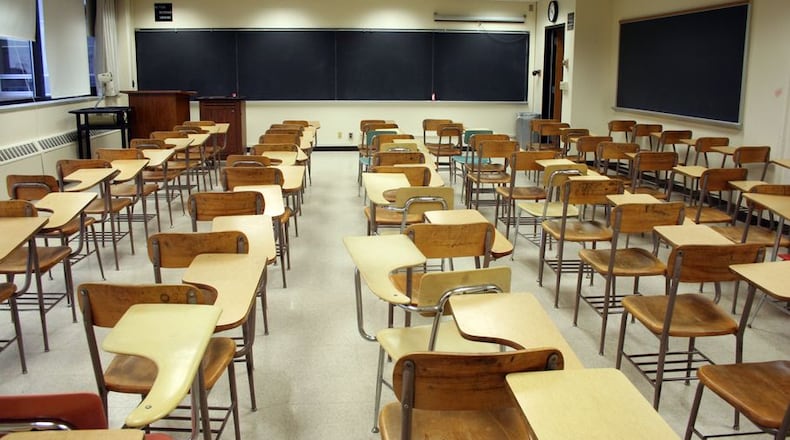No one is sure how and when America’s schools will reopen and what the return of 54 million children isolated at home by the coronavirus shutdown will entail.
“K-12 schools will have the hardest summer they ever had,” said Ben Scafidi, director of the Education Economics Center at Kennesaw State University and a former education policy adviser to Govs. Sonny Perdue and Roy Barnes. “There is so much uncertainty.”
There’s even little agreement on how schools should wrap up this lost quarter, with suggestions ranging from giving every child A’s due to the disruption in their learning to holding back every student in struggling schools where most kids were already behind grade level.
In recognition of the failings of crisis schooling, school board members in San Francisco proposed giving all middle and high students A’s for the period they were home-bound and reliant on distance learning.
“Let’s just consider this a wash and just give all students A’s,” said San Francisco Board of Education Commissioner Alison Collins earlier this month. The California Department of Education and the University of California System weren’t as keen on the idea, so San Francisco may go with the fallback solution chosen by many districts — pass/fail grades.
Mike Petrilli, president of the Thomas B. Fordham Institute, a conservative education think tank, set off a vigorous debate on Twitter with his recommendation that low-income, low-performing students remain in their current grade with their current teachers when school resumes in the fall. The familiarity, he said, will ease the return to school and allow for the development of personalized learning plans to address gaps.
And there will be gaps, although experts disagree on how consequential they will be.
In a new analysis, the NWEA, the organization behind the widely used Measures of Academic Progress or MAP testing, says students may return with less than 50% of typical learning gains in math, and in some grades, nearly a year behind where expected in normal times. The outlook improved for reading, where the NWEA predicts students will return in fall with about 70% of the learning gains relative to a typical year.
“We can’t go into fall, or whenever these schools open up again, and hope everything will be OK. Hope is not a strategy,” said Stephen Pruitt, president of the Atlanta-based Southern Regional Education Board and former Kentucky state commissioner of education. “We have to recognize there are going to be deficiencies. We are going to be in a place where we actually have to diagnose far more than we ever have before to ensure we can provide quality education.”
Also unknown is whether schools can return to traditional schedules. Given health forecasts that the coronavirus could reemerge in the fall, Scafidi voiced doubts. “Students will be outside school walls for many, many days next year,” said Scafidi. “Either they will go back and be quarantined later, or schools are going to have to go to part-time schedules.”
His suggestion: Public schools consider a hybrid home-school model where students are learning in school two or three days and at home the other days. To enable that innovation, Scafidi advocates a suspension of federal testing requirements for the 2020-2021 school year and urges states, including Georgia, to seek a testing waiver now.
“One way or the other, it is pretty clear kids will be spending a lot of time at home,” he said. “We are not going to teach all the content needed to give those state tests. Public schools have so much to worry about in getting technology and internet access to low-income children; they have to worry about how they are going to attempt to meet the needs of special need students. The federal government needs to give public schools the opportunity to deal with that reality.”
And that reality will be complicated and expensive at a time when states will be confronting massive shortfalls.
For example, if social distancing is required, it's been suggested schools go to split sessions so fewer students are in the building at one time. "If you go to half the kids in the morning and half the kids in the afternoon, you are doubling your bus routes, and that is a significant change in your budget," said Pruitt on a webinar last week for education writers sponsored by Education Week.
“Will teachers need personal protection equipment? Who will pay for that?” asked Sonja Brookins Santelises on the same webinar; she is CEO of Baltimore City Public Schools and former vice president for K-12 policy and practice at the Education Trust.
Santelises is exploring possible reopening scenarios for her schools, although she’s certain of one thing. “In Baltimore City schools, we are not going to keep kids back because of the COVID quarter,” she said. “We know what the research says on that. We know that it does not work.”
Instead, Santelises echoed what many other school leaders around the country are saying: The focus will be on acceleration and teaching targeted skills based on where students display severe learning gaps. A top priority for her: “How do we get the children who are furthest behind with the largest gaps in front of the teachers who we know from the data have the greatest skills in moving kids?”
About the Author
The Latest
Featured



